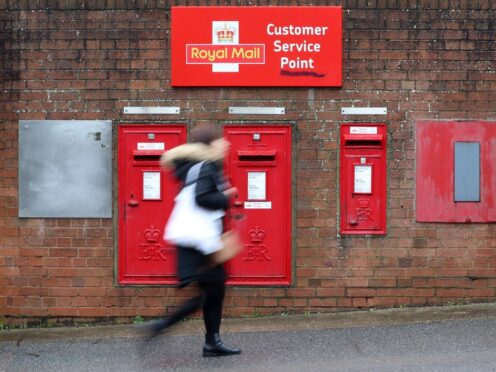Royal Mail has put forward proposals that would see first-class mail kept as a six-days-a-week service, but second-class letter deliveries cut dramatically.
It comes as part of the group’s submission to regulator Ofcom, which is consulting on reforms of the universal postal service.
Here the PA news agency looks at what is being put on the table and why:
– What is Royal Mail proposing?
The company is proposing that all non first-class letter deliveries – including second class and bulk business mail, such as bills and statements – are cut to every other weekday.
This would mean that second-class deliveries on Saturdays would be scrapped.
Under the plans, Royal Mail would deliver second-class mail in some streets on Monday, Wednesday and Friday, with others receiving letters on Tuesday and Thursday.
The delivery schedule would be alternated every week.
First-class letter deliveries would remain six days a week, while Royal Mail said parcels would continue to be delivered up to seven days a week.
– Why is Royal Mail proposing this?
Royal Mail said the moves would save it up to £300 million a year, with the universal postal service currently costing it up to £675 million every year.
The cuts to second-class deliveries could see it axe up to 1,000 jobs, although it hopes this can be achieved through voluntary redundancy and staff turnover.
– What is the universal postal service?
Royal Mail’s universal service obligation (USO) stipulates that it must deliver letters six days a week to all UK addresses for the price of a stamp.
It must also deliver parcels Monday to Friday, as well as offer a first-class (next day) and second-class post (within three days).
– Why is Ofcom looking to overhaul the service?
The watchdog said that the universal service risks becoming “unsustainable” without reform.
It said Britons are sending half as many letters as they did in 2011, down from 14.3 billion to 7.3 billion now, and instead receiving many more parcels.

Royal Mail has also argued that the service needs to change.
The group has been heavily loss-making, while it has also failed to meet its delivery performance targets, which landed it with a £5.6 million fine from Ofcom last year.
But the latest proposals mark a climbdown on its previous calls for all Saturday letter deliveries to be scrapped.
– What has Ofcom suggested so far?
In January, the regulator outlined two “primary options”, including changes to the number of days that letters are delivered a week.
That could mean cutting Royal Mail’s letter delivery service from six days to five, or even three, a week.
The other option was to extend how long it takes letters to be delivered, meaning that it would take three or more days for most letters to arrive, but with a more expensive next-day delivery service available when required.
But it has been quick to stress that they were only “potential options” and not firm recommendations.

– What power does Ofcom have to change the service?
Ofcom cannot scrap Saturday letter deliveries or reduce the delivery days, with the six-day-a-week service being part of the universal service requirement stipulated by law under the Postal Services Act 2011.
The Government and Parliament would therefore have to sanction cutting a six-day service.
But as Royal Mail would continue to deliver first class mail on Saturdays under its proposals, it claims the reduction in the second class mail service would not need a change in the law.
– How does it work in other countries?
Ofcom said the UK is not alone in needing to change delivery services due to fewer letters being posted as people instead use email and social media.
It said other countries have cut the frequency of delivery or extended delivery times for letters, such as Sweden in 2018, Belgium twice since 2020, and Norway and Denmark twice each since 2016.
– Will the changes mean deliveries will become more expensive?
Ofcom has recommitted to capping the cost of posting second-class letters until March 2027, ensuring that on average it will rise by no more than Consumer Prices Index inflation.
But it does not cap first-class delivery costs.
The Liberal Democrats have argued that the changes put forward by Royal Mail “risk creating a cost of postage crisis, as people feel forced to pay for first-class stamps because second-class delivery days are being slashed”.
– What will happen from here?
Ofcom has been consulting on the postal reforms since January, with a deadline set for April 3.
It said it wanted there to be a “national debate” on the future of the postal service and has been holding events across the UK, such as round table discussions with various groups.
The regulator aims to report back with an update in the summer.
